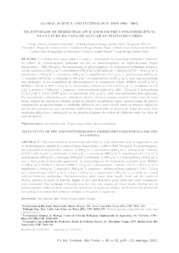Seletividade de herbicidas aplicados em pré e pós-emergência na cultura da cana-de-açúcar ao feijão-de-corda.
Seletividade de herbicidas aplicados em pré e pós-emergência na cultura da cana-de-açúcar ao feijão-de-corda.
Author(s): FERNANDES, C. P. C.; BRAZ, A. J. B. P.; PROCOPIO, S. de O.; DAN, H. de A.; BRAZ, G. B. P.; BARROSO, A. L. de L.; MENEZES, C. C. E.; SIMON, G. A.; BRAZ, L. B. P.
Summary: RESUMO: O trabalho teve como objetivo avaliar a seletividade dos principais herbicidas utilizados na cultura da cana-de-açúcar, aplicados em pré ou pós-emergência, ao feijão-de-corda (Vigna unguiculata ? BRS Novaera). Na modalidade de pré-emergência os tratamentos herbicidas avaliados foram: ametryn (2.500 g ha-1), tebuthiuron (800 g ha-1), [hexazinone + diuron] (237,6 + 842,4 g ha-1), metribuzin (1.440 g ha-1), clomazone (800 g ha-1), isoxaflutole (112,5 g ha-1), sulfentrazone (600 g ha-1), imazapic (105 g ha-1), trifluralin (1.800 g ha-1) e s-metolachlor (1.920 g ha-1), mais uma testemunha sem aplicação. Já na modalidade de pós-emergência os tratamentos foram: MSMA (1.440 g ha-1), MSMA + diuron (1.080 + 420 g ha-1), [hexazinone + diuron] (237,6 + 842,4 g ha-1), metribuzin (1.440 g ha-1), ametryn (1.500 g ha-1), [ametryn + trifloxysulfuron sodium] (1.280 + 32,4 g ha-1), halosulfuron (112,5 g ha-1), 2,4-D (1.005 g ha-1) e mesotrione (120 g ha-1), mais uma testemunha sem aplicação. Foram avaliadas a fitointoxicação, estande de plantas, altura de plantas, matéria verde e seca da parte aérea, número de plantas na colheita, altura de inserção da primeira vagem, produtividade de grãos e componentes da produtividade. O herbicida trifluralin foi o único dentre todos os testados, sejam em pré ou pós-emergência, que apresentou seletividade satisfatória às plantas de feijão-de-corda. Tais resultados dificultam a formatação de um sistema integrado de cultivo de feijão-de-corda em áreas de cana-de-açúcar. Selectivity of pre and postemergence herbicides used for sugarcane to cowpea. ABSTRACT: This work aimed to evaluate the selectivity of main herbicides used in sugarcane at pre or postemergence applied in cowpea (Vigna unguiculata ? cultivar BRS Novaera). To preemergence, the treatments evaluated were: ametryn (2,500 g ha-1), tebuthiuron (800 g ha-1), [hexazinone + diuron] (237.6 + 842.4 g ha-1), metribuzin (1,440 g ha-1), clomazone (800 g ha-1), isoxaflutole (112.5 g ha-1), sulfentrazone (600 g ha-1), imazapic (105 g ha-1), trifluralin (1,800 g ha-1), s-metolachlor (1,920 g ha-1), and a check without herbicide application. At postemergence, the treatments evaluated were: MSMA (1,440 g ha-1), MSMA + diuron (1,080 + 420 g ha-1), [hexazinone + diuron] (237.6 + 842.4 g ha-1), metribuzin (1,440 g ha-1), ametryn (1,500 g ha-1), [ametryn + trifloxysulfuron sodium] (1,280 + 32.4 g ha-1), halosulfuron (112.5 g ha-1), 2.4-D (1,005 g ha-1), mesotrione (120 g ha-1), as wells as a check without herbicide application. Phytointoxication, plant stand, plant height, fresh and dry matter of shoots, number of plants at harvest, height of first pod insertion, grain yield and yield components were evaluated. The herbicide trifluralin was the only one among all those tested, whether pre or postemergence, which showed satisfactory selectivity to plants of cowpea. Such results complicate the formatting of an integrated system of cowpea in the areas of sugarcane.
Publication year: 2012
Types of publication: Journal article
Unit: Embrapa Soybean
Keywords: Herbicidas
Observation
Some of Embrapa's publications are published as ePub files. To read them, use or download one of the following free software options to your computer or mobile device. Android: Google Play Books; IOS: iBooks; Windows and Linux: Calibre.
Access other publications
Access the Agricultural Research Database (BDPA) to consult Embrapa's full library collection and records.
Visit Embrapa Bookstore to purchase books and other publications sold by Embrapa.

